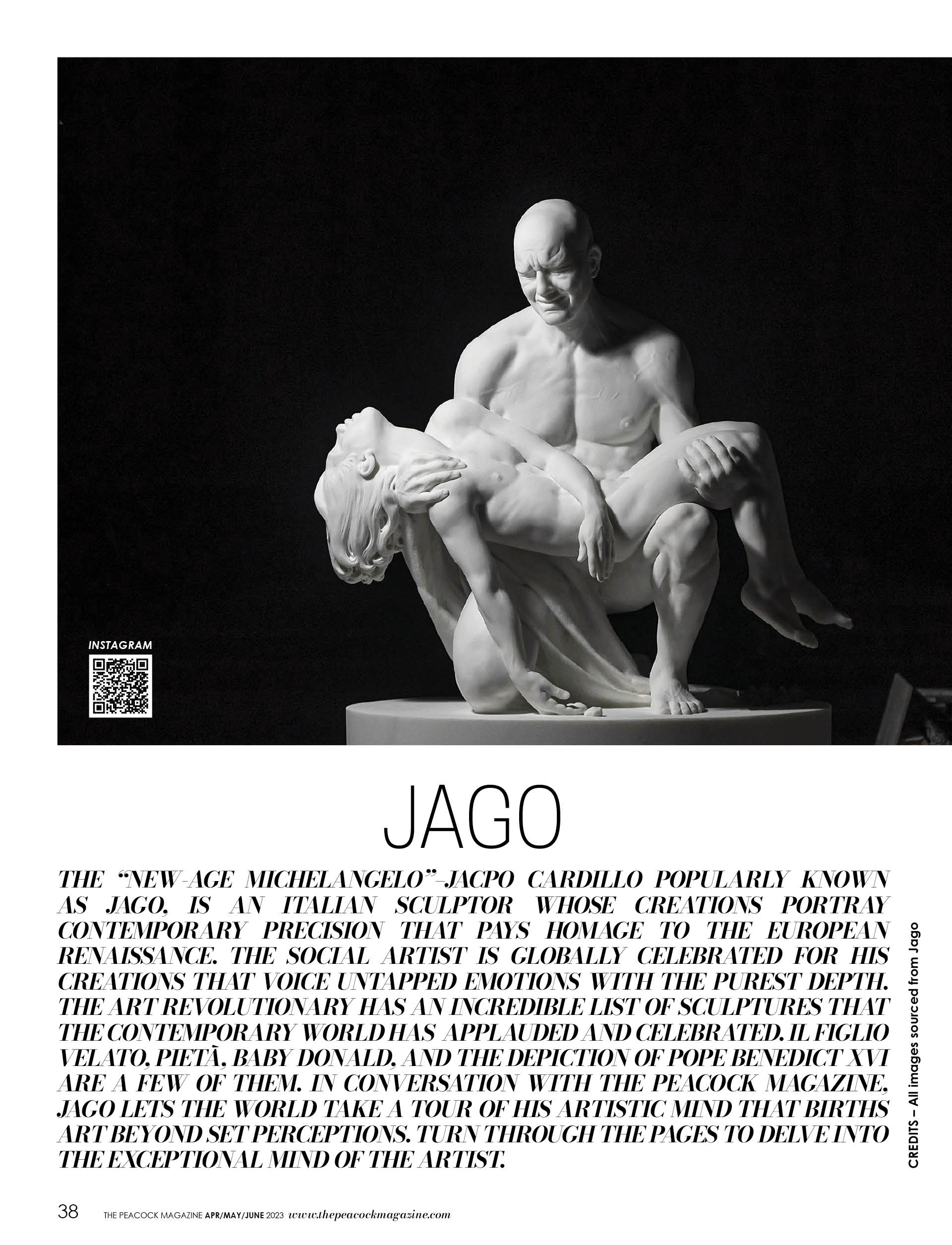
CREDITS: All images sourced from Jago
The “new-age Michelangelo”—Jacpo Cardillo popularly known as Jago, is an Italian sculptor whose creations portray contemporary precision that pays homage to the European Renaissance. The social artist is globally celebrated for his creations that voice untapped emotions with the purest depth. The art revolutionary has an incredible list of sculptures that the contemporary world has applauded and celebrated. Il Figlio Velato, Pietà, Baby Donald, and the depiction of Pope Benedict XVI are a few of them. In conversation with The Peacock Magazine, Jago lets the world take a tour of his artistic mind that births art beyond set perceptions. Turn through the pages to delve into the exceptional mind of the artist.
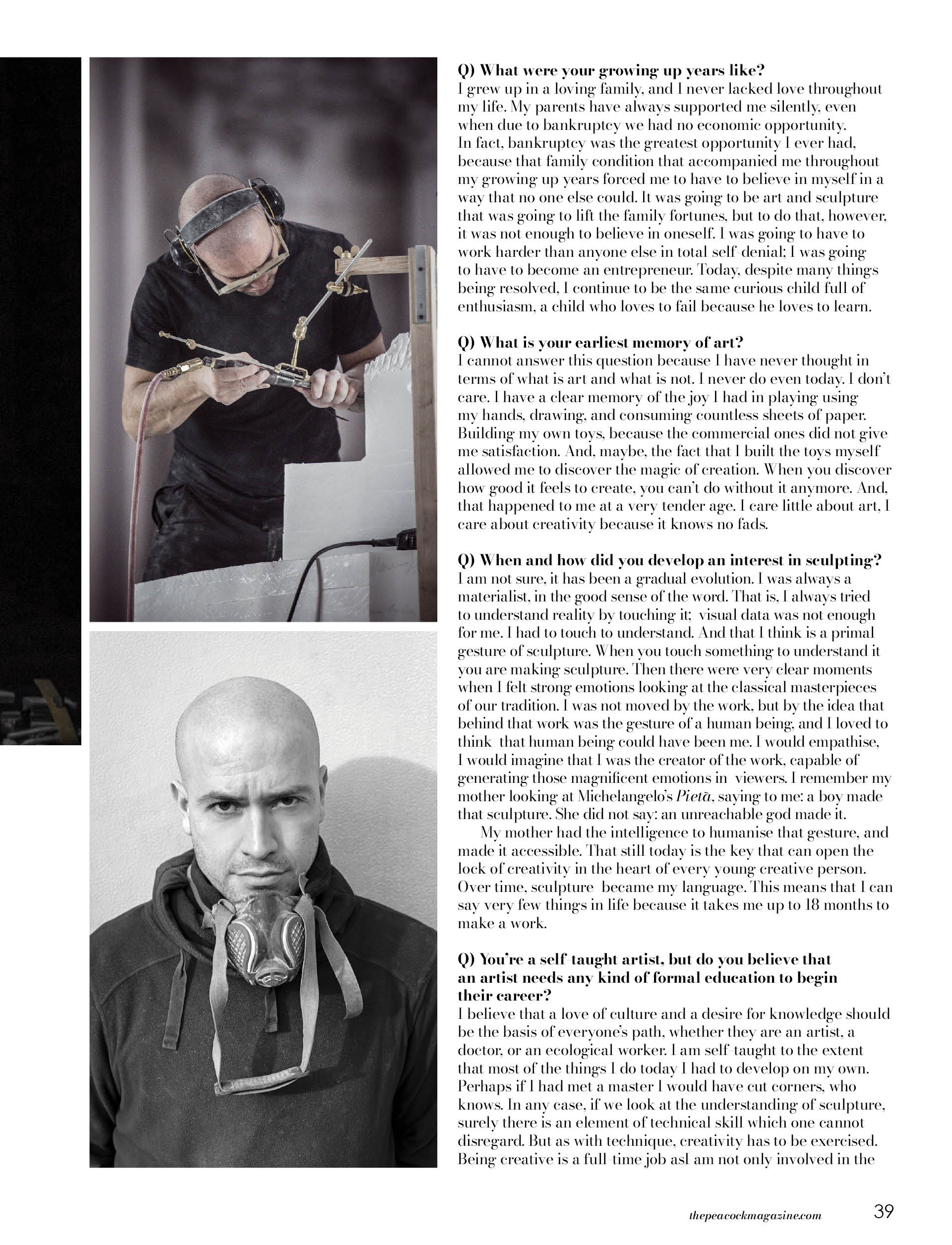
Q) What were your growing up years like?
I grew up in a loving family, and I never lacked love throughout my life. My parents have always supported me silently, even when due to bankruptcy we had no economic opportunity. In fact, bankruptcy was the greatest opportunity I ever had, because that family condition that accompanied me throughout my growing up years forced me to have to believe in myself in a way that no one else could. It was going to be art and sculpture that was going to lift the family fortunes, but to do that, however, it was not enough to believe in oneself. I was going to have to work harder than anyone else in total self-denial; I was going to have to become an entrepreneur. Today, despite many things being resolved, I continue to be the same curious child full of enthusiasm, a child who loves to fail because he loves to learn.
Q) What is your earliest memory of art?
I cannot answer this question because I have never thought in terms of what is art and what is not. I never do even today. I don’t care. I have a clear memory of the joy I had in playing using my hands, drawing, and consuming countless sheets of paper. Building my own toys, because the commercial ones did not give me satisfaction. And, maybe, the fact that I built the toys myself allowed me to discover the magic of creation. When you discover how good it feels to create, you can’t do without it anymore. And, that happened to me at a very tender age. I care little about art, I care about creativity because it knows no fads.
Q) When and how did you develop an interest in sculpting?
I am not sure, it has been a gradual evolution. I was always a materialist, in the good sense of the word. That is, I always tried to understand reality by touching it; visual data was not enough for me. I had to touch to understand. And that I think is a primal gesture of sculpture. When you touch something to understand it you are making sculpture. Then there were very clear moments when I felt strong emotions looking at the classical masterpieces of our tradition. I was not moved by the work, but by the idea that behind that work was the gesture of a human being, and I loved to think that human being could have been me. I would empathise, I would imagine that I was the creator of the work, capable of generating those magnificent emotions in viewers. I remember my mother looking at Michelangelo’s Pietà, saying to me: a boy made that sculpture. She did not say: an unreachable god made it.
My mother had the intelligence to humanise that gesture, and made it accessible. That still today is the key that can open the lock of creativity in the heart of every young creative person. Over time, sculpture became my language. This means that I can say very few things in life because it takes me up to 18 months to make a work.
Q) You’re a self-taught artist, but do you believe that an artist needs any kind of formal education to begin their career?
I believe that a love of culture and a desire for knowledge should be the basis of everyone’s path, whether they are an artist, a doctor, or an ecological worker. I am self-taught to the extent that most of the things I do today I had to develop on my own. Perhaps if I had met a master I would have cut corners, who knows. In any case, if we look at the understanding of sculpture, surely there is an element of technical skill which one cannot disregard. But as with technique, creativity has to be exercised. Being creative is a full-time job asI am not only involved in the creation of “my” artefacts, many others depend on my work; in short, I am not the stereotypical “artist” of whom one likes to possess or nurture a romantic idea, that is, an artist is someone without an economic consciousness and with their head in the clouds. My work has a very specific function, and having to keep up with the times in an ever-changing world, one never stops training.
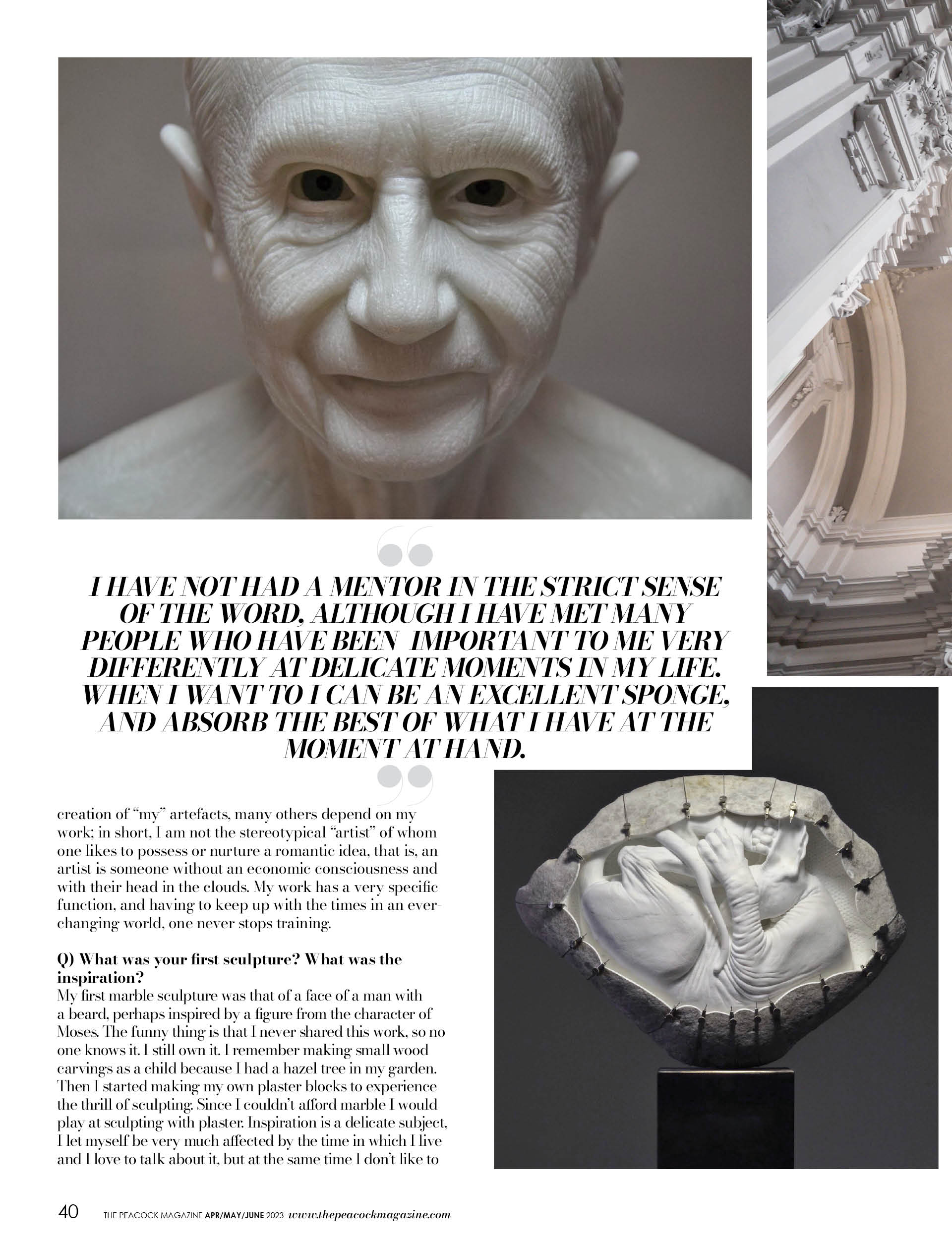
Q) What was your first sculpture? What was the inspiration?
My first marble sculpture was that of a face of a man with a beard, perhaps inspired by a figure from the character of Moses. The funny thing is that I never shared this work, so no one knows it. I still own it. I remember making small wood carvings as a child because I had a hazel tree in my garden. Then I started making my own plaster blocks to experience the thrill of sculpting. Since I couldn’t afford marble I would play at sculpting with plaster. Inspiration is a delicate subject, I let myself be very much affected by the time in which I live and I love to talk about it, but at the same time I don’t like to be rhetorical. Instead, I prefer my work to risk standing the test of time. Using marble sculpture to talk about our contemporary time, and yet hoping it to still be relevant in 1,000 years is quite a challenge.

Q) People often call you the modern-day Michelangelo. How do you feel about that? What about him inspires you?
I think it is an exaggerated comparison, an association made genuinely by someone who wants to make the interlocutor understand what he is talking about. That is, of a sculptor who carves marble and deals with themes that have a traditional flavour. Actually, I don’t really care much about these associations because I want to be the new me. Michelangelo was and will forever remain a fundamental master and I thank life for giving us the gift of him. I also think it is important to start from someone’s footsteps to find your own. It is good and necessary to have benchmarks, and the higher they are, the harder you will have to work to get to their level. A child should always compare himself with excellence, and he should always be encouraged when he imagines he is the next Leonardo da Vinci or the next Bill Gates, because in that vision there is a pure sense of emulation that if cultivated can make a big difference. Instead very often, today, a child who dreams is told not to do it, to be humble, because having a dream is risky. Instead, the real risk is to stop dreaming.
Q) Who was your mentor? What was your relationship with him/her like?
I wished I had a mentor all my life, then I found that anyone could be one for me. My rule is to surround myself with people who are better than me. Nowadays we have access to an infinite amount of content, and if you love to read, you live more lives, other people’s lives, but if you don’t like to read, that’s okay, you just live your own. However, I have not had a mentor in the strict sense of the word, although I have met many people who have been important to me very differently at delicate moments in my life. When I want to I can be an excellent sponge, and absorb the best of what I have at the moment at hand.
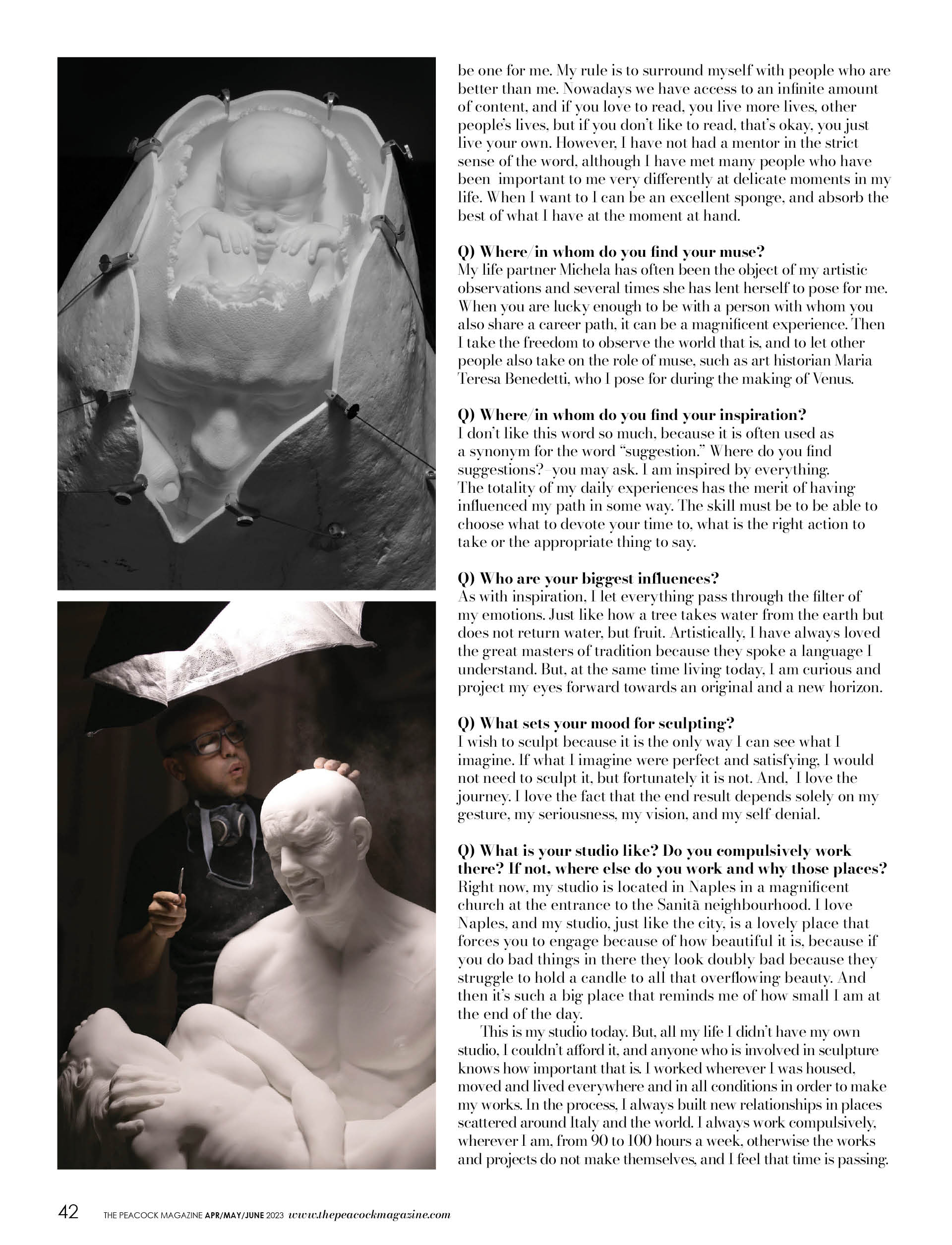
Q) Where/in whom do you find your muse?
My life partner Michela has often been the object of my artistic observations and several times she has lent herself to pose for me. When you are lucky enough to be with a person with whom you also share a career path, it can be a magnificent experience. Then I take the freedom to observe the world that is, and to let other people also take on the role of muse, such as art historian Maria Teresa Benedetti, who I pose for during the making of Venus.
Q) Where/in whom do you find your inspiration?
I don’t like this word so much, because it is often used as a synonym for the word “suggestion.” Where do you find suggestions?—you may ask. I am inspired by everything. The totality of my daily experiences has the merit of having influenced my path in some way. The skill must be to be able to choose what to devote your time to, what is the right action to take or the appropriate thing to say.
Q) Who are your biggest influences?
As with inspiration, I let everything pass through the filter of my emotions. Just like how a tree takes water from the earth but does not return water, but fruit. Artistically, I have always loved the great masters of tradition because they spoke a language I understand. But, at the same time living today, I am curious and project my eyes forward towards an original and a new horizon.
Q) What sets your mood for sculpting?
I wish to sculpt because it is the only way I can see what I imagine. If what I imagine were perfect and satisfying, I would not need to sculpt it, but fortunately it is not. And, I love the journey. I love the fact that the end result depends solely on my gesture, my seriousness, my vision, and my self-denial.
Q) What is your studio like? Do you compulsively work there? If not, where else do you work and why those places?
Right now, my studio is located in Naples in a magnificent church at the entrance to the Sanità neighbourhood. I love Naples, and my studio, just like the city, is a lovely place that forces you to engage because of how beautiful it is, because if you do bad things in there they look doubly bad because they struggle to hold a candle to all that overflowing beauty. And then it’s such a big place that reminds me of how small I am at the end of the day.
This is my studio today. But, all my life I didn’t have my own studio, I couldn’t afford it, and anyone who is involved in sculpture knows how important that is. I worked wherever I was housed, moved and lived everywhere and in all conditions in order to make my works. In the process, I always built new relationships in places scattered around Italy and the world. I always work compulsively, wherever I am, from 90 to 100 hours a week, otherwise the works and projects do not make themselves, and I feel that time is passing.
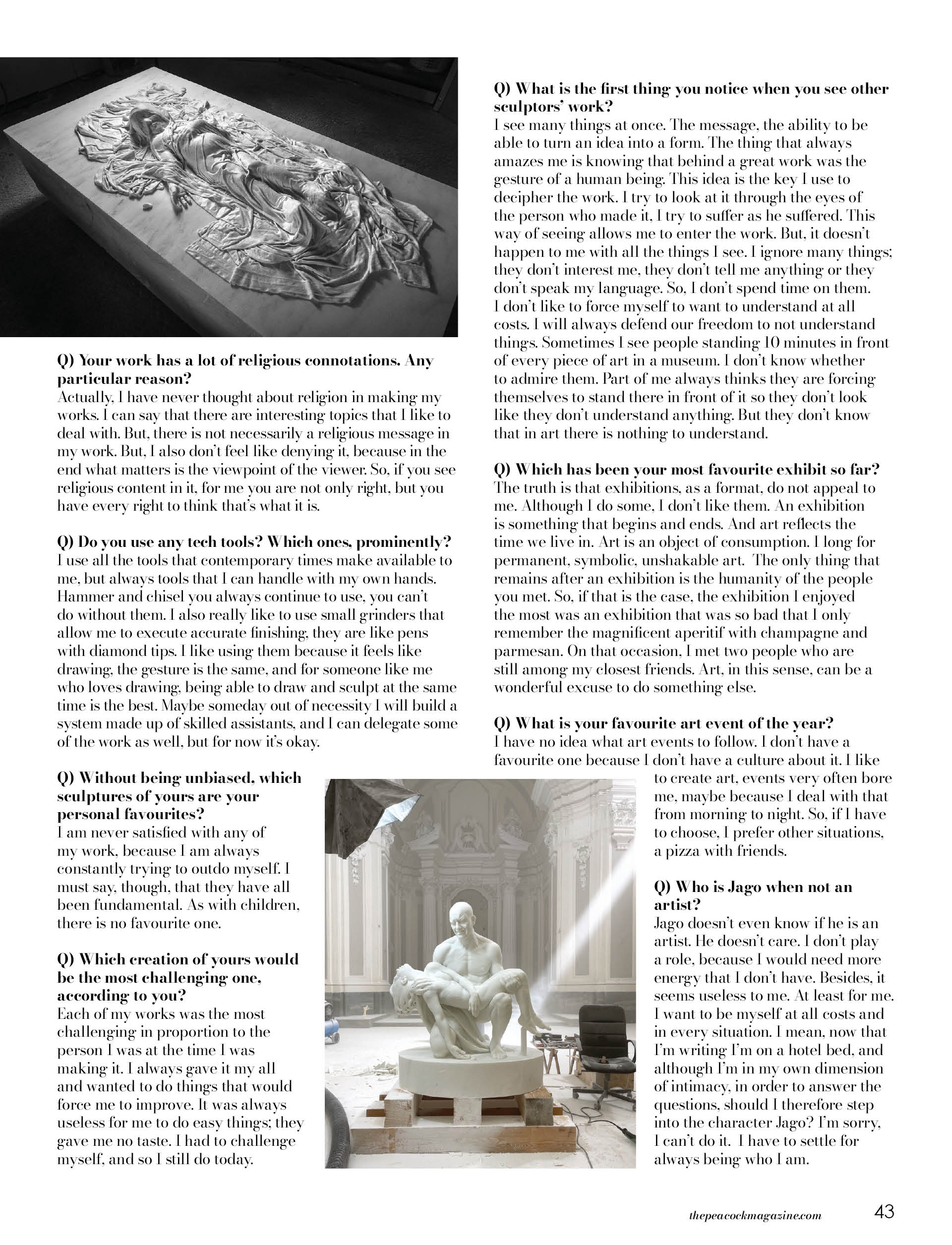
Q)Your work has a lot of religious connotations. Any particular reason?
Actually, I have never thought about religion in making my works. I can say that there are interesting topics that I like to deal with. But, there is not necessarily a religious message in my work. But, I also don’t feel like denying it, because in the end what matters is the viewpoint of the viewer. So, if you see religious content in it, for me you are not only right, but you have every right to think that’s what it is.
Q) Do you use any tech tools? Which ones, prominently?
I use all the tools that contemporary times make available to me, but always tools that I can handle with my own hands. Hammer and chisel you always continue to use, you can’t do without them. I also really like to use small grinders that allow me to execute accurate finishing, they are like pens with diamond tips. I like using them because it feels like drawing, the gesture is the same, and for someone like me who loves drawing, being able to draw and sculpt at the same time is the best. Maybe someday out of necessity I will build a system made up of skilled assistants, and I can delegate some of the work as well, but for now it’s okay.
Q) Without being unbiased, which sculptures of yours are your personal favourites?
I am never satisfied with any of my work, because I am always constantly trying to outdo myself. I must say, though, that they have all been fundamental. As with children, there is no favourite one.
Q) Which creation of yours would be the most challenging one, according to you?
Each of my works was the most challenging in proportion to the person I was at the time I was making it. I always gave it my all and wanted to do things that would force me to improve. It was always useless for me to do easy things; they gave me no taste. I had to challenge myself, and so I still do today.
Q) What is the first thing you notice when you see other sculptors’ work?
I see many things at once. The message, the ability to be able to turn an idea into a form. The thing that always amazes me is knowing that behind a great work was the gesture of a human being. This idea is the key I use to decipher the work. I try to look at it through the eyes of the person who made it, I try to suffer as he suffered. This way of seeing allows me to enter the work. But, it doesn’t happen to me with all the things I see. I ignore many things; they don’t interest me, they don’t tell me anything or they don’t speak my language. So, I don’t spend time on them. I don’t like to force myself to want to understand at all costs. I will always defend our freedom to not understand things. Sometimes I see people standing 10 minutes in front of every piece of art in a museum. I don’t know whether to admire them. Part of me always thinks they are forcing themselves to stand there in front of it so they don’t look like they don’t understand anything. But they don’t know that in art there is nothing to understand.
Q) Which has been your most favourite exhibit so far?
The truth is that exhibitions, as a format, do not appeal to me. Although I do some, I don’t like them. An exhibition is something that begins and ends. And art reflects the time we live in. Art is an object of consumption. I long for permanent, symbolic, unshakable art. The only thing that remains after an exhibition is the humanity of the people you met. So, if that is the case, the exhibition I enjoyed the most was an exhibition that was so bad that I only remember the magnificent aperitif with champagne and parmesan. On that occasion, I met two people who are still among my closest friends. Art, in this sense, can be a wonderful excuse to do something else.
Q) What is your favourite art event of the year?
I have no idea what art events to follow. I don’t have a favourite one because I don’t have a culture about it. I like to create art, events very often bore me, maybe because I deal with that from morning to night. So, if I have to choose, I prefer other situations, a pizza with friends.
Q) Who is Jago when not an artist?
Jago doesn’t even know if he is an artist. He doesn’t care.
I don’t play a role, because I would need more energy that I don’t have. Besides, it seems useless to me. At least for me. I want to be myself at all costs and in every situation. I mean, now that I’m writing I’m on a hotel bed, and although I’m in my own dimension of intimacy, in order to answer the questions, should I therefore step into the character Jago? I’m sorry, I can’t do it. I have to settle for always being who I am.
